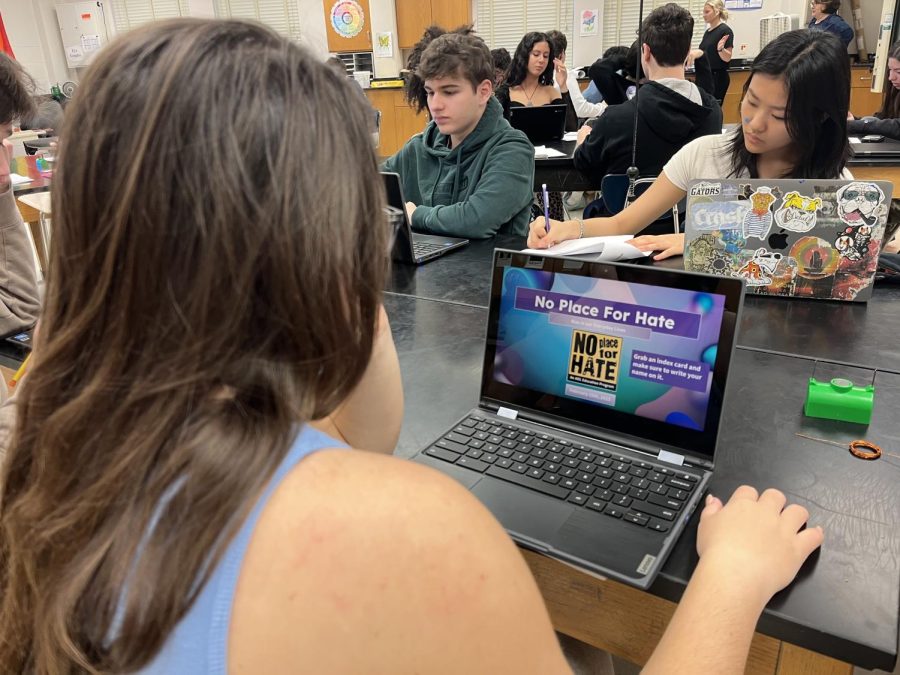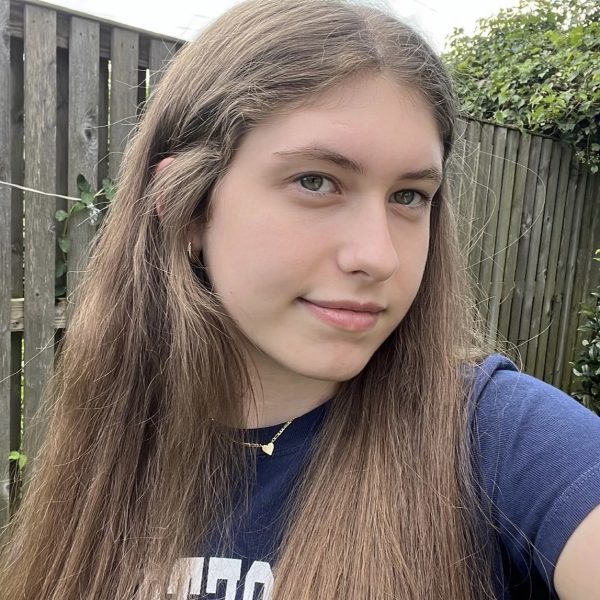WCHS takes new initiatives to stop hate bias
On Feb. 15, students completed the “No Place for Hate” Pride lesson. The lesson aimed to educate students on how to stop hate bias at WCHS.
March 2, 2023
School should be a safe and inclusive place for everyone. From learning in class to eating lunch with friends, students spend most of their time at school. However, when instances of hate bias occur—harmful actions motivated by another person’s race, disability, religion, national origin, sexual orientation, or gender identity—school becomes the opposite of what it is meant to be.
On Feb. 13, hate-based graffiti was found in a boys’ bathroom. The graffiti was a “racially based joke on the wall that referenced the “N” word,” according to Principal Taylor’s email sent out after school on Feb. 13. As WCHS strives to create a community where everyone is embraced, students and staff alike have been hurt by this incident.
“It makes me sad that someone felt the need to put hurtful words on our school property,” Assistant School Administrator Dr. Ericka Mbachu said. “As hard as we work to build an inclusive community, some do not realize the impact of their hurtful words on members of our community.”
The graffiti was quickly reported to building services, who removed the hateful remarks. The student(s) responsible for the graffiti is still unknown, but administrators continue to search for the perpetrators. MCPS Office of School Security and Emergency Management and the Montgomery County Police are also involved in the investigation.
“At this time, the student(s) involved have not been caught,” Mbachu said. “We are still investigating the incident. Once individuals have been identified, the admin will follow the MCPS student code of conduct. It is important that these incidents are reported as soon as possible.”
In an effort to combat hate bias at WCHS and decrease the number of hate-based remarks—whether graffiti, speech or other writing—students engaged in “No Place for Hate” Pride lessons on Feb. 15 and March 1. These lessons aimed to educate students on hate bias incidents across MCPS and how to actively stop hateful incidents from occurring.
“The main thing that students should take away from both Pride lessons is to stop and think about the impact of their actions and words,” Mbachu said. “Sometimes things said as a joke may not have the intended effect and may be hurtful to others. It is important to recognize that everyone’s daily experience differs, so students should pause and think before speaking and acting.”
The Feb. 15 Pride presentation included statistics about the number of hate bias incidents across MCPS for the 2022-23 school year, currently totaling 57 incidents as of Feb. 8. In 2023 alone, there have already been 30 incidents, a significant increase compared to the beginning of the school year.
“I didn’t realize before just how many instances of hate there have been this year in MCPS, and I think the Pride lesson did a good job of educating students on how to prevent them,” WCHS junior Jessa Bradley-Bunkin said. “In my class, we had great conversations about it, and it felt nice to have people to talk to about such a serious topic. However, I know in many other classes, students weren’t engaged in the lesson, so they didn’t take anything away from it. Unfortunately, most students don’t take Pride seriously, making these lessons ineffective schoolwide.”
One resource provided in the Feb. 15 presentation, a three-step callout system, outlines how students are supposed to “name,” “claim,” and “stop” biased attitudes and acts of bias as they occur. The March 1 lesson also built off this, including a “Pyramid of Hate,” which allows students to reflect on how different types of bias build on each other. Despite the value of the information provided, many students will unfortunately not utilize these resources.
“The three-step callout system is interesting and useful to know, but I don’t think a lot of students will use it,” Bradley-Bunkin said. “Unless their friend says something hurtful, I don’t think students would get involved and use the system. People prefer to mind their own business and don’t see any use in stopping the hate they hear. Same with the Pyramid of Hate; many students won’t take the time to go through the levels and reflect on their actions.”
While calling out hate bias can be intimidating, and many students would prefer not to get involved, it is important to remember that addressing discrimination is necessary to create a more inclusive community. At WCHS, there is a high emphasis on embracing and celebrating all people and cultures in our school.
“It is important to speak up when we see people doing things we know may hurt others,” Mbachu said. “As a student, it is okay to educate your friends and speak to them when you know that they are doing or saying something hurtful to someone in our community. The more we bring these incidents to light, the easier it is for people to recognize the damage it does to members of our community.”
As hate bias is a prominent issue at WCHS and the whole county, students and staff can be negatively affected by biased incidents. Hate bias makes targeted groups feel ostracized at school, a place that is supposed to be safe and welcoming. Creating a more inclusive environment is something everyone should work on one way or another.
“People shouldn’t have to worry about hate bias at their school,” Bradley-Bunkin said. “It makes school less enjoyable and unsafe for students and staff. With the wide variety of different groups at WCHS, people need to feel protected from discrimination. I think students would be more motivated to try their best if they felt respected and heard in school, which is not happening now. We still have much to do, but educating ourselves and getting involved when we see something harmful is a step in the right direction.”



